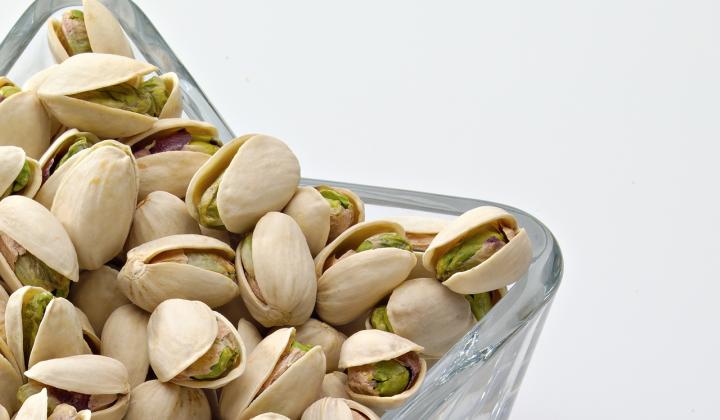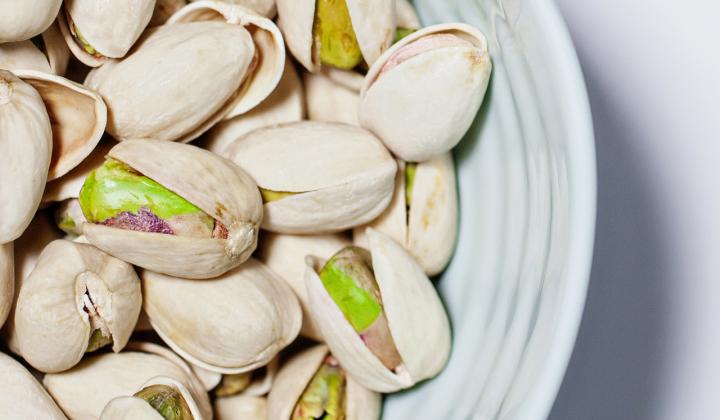Pistachios may have you thinking green, because this little green nut packs a powerful punch of nutrition benefits. Research suggests the many attributes of pistachios—full of essential nutrients, antioxidants, dietary fiber, protein, and healthy fats—work together to promote good health, reduce the risk of nutrition-related disease, and support an active lifestyle1. But it’s experience that suggests these nuts are delicious, convenient, and versatile enough to kick up the flavor and nutrition of meals and snacks to promote optimal health.
A one-ounce serving of shelled pistachios contains only 160 calories, and provides a bonus of healthy fats (4 grams polyunsaturated and 7 grams monounsaturated), 6 grams protein, 3 grams fiber, and more than 10% of the Daily Value of essential vitamins and minerals, like vitamin B6, thiamin, copper, and phosphorus. No wonder pistachio consumption is linked with health benefits.
Plant-Based Eating
Plant-powered pistachios are part of a healthful plant-based eating style, such as Mediterranean, vegetarian, or flexitarian diets, because they can replace animal foods in meals. Pistachios pack an impressive 6 grams of protein in a one-ounce serving, counting as a protein group serving, according to USDA MyPlate2. A number
of health benefits have been linked with plant-based eating styles, including lower risks of heart disease, high blood pressure, type 2 diabetes, certain types of cancer, and obesity.3 It’s easy to understand why: plant-based diets are higher in fiber, certain vitamins and minerals, and phytochemicals (plant compounds with health protective properties); and lower in saturated fat and dietary cholesterol than meat-heavy diets. Therein lies the health benefit.3
Heart Health
 Munching on pistachios is a heart-healthy endeavor, as this habit can help support a strong heart and healthy blood vessels. Naturally cholesterol-free, packed with heart-healthy fats, fiber, essential nutrients, and phytochemicals, this mighty green gem may help lower LDL cholesterol and support healthy total cholesterol levels. The FDA granted pistachios (as part of tree nuts) a qualified health claim, “Scientific evidence suggests but does not prove that eating 1.5 ounces of most nuts, such as pistachios, as part of a diet low in saturated fat and cholesterol may lower the risk of heart disease.” 4
Munching on pistachios is a heart-healthy endeavor, as this habit can help support a strong heart and healthy blood vessels. Naturally cholesterol-free, packed with heart-healthy fats, fiber, essential nutrients, and phytochemicals, this mighty green gem may help lower LDL cholesterol and support healthy total cholesterol levels. The FDA granted pistachios (as part of tree nuts) a qualified health claim, “Scientific evidence suggests but does not prove that eating 1.5 ounces of most nuts, such as pistachios, as part of a diet low in saturated fat and cholesterol may lower the risk of heart disease.” 4
The landmark PREDIMED study published in the New England Journal of Medicine showed a Mediterranean diet supplemented with nuts, such as pistachios, significantly reduced cardiac events. In this clinical trial of about 7400 subjects, those who ate a Mediterranean diet with either one ounce of nuts per day or one liter of olive oil per week had a 30% risk reduction in heart disease-related events.5 Pistachios likely reduce overall heart disease risk beyond just a decrease in total and LDL cholesterol alone. Numerous studies have looked at the effects of eating pistachios on many risk factors for cardiovascular disease, suggesting that eating pistachios daily (1 to 3 ounces, or as 10-20% of calories) may reduce the risk of heart disease in five ways:
- Lowering total cholesterol, LDL cholesterol and non-HDL cholesterol 6
- Increasing antioxidants in the blood and decreasing oxidized-LDL 7
- Decreasing small dense LDL and increasing phytosterols levels in the blood 8,9
- Providing beneficial anti-inflammatory properties 10
- Reducing acute stress by lowering blood pressure, heart rate and peripheral vascular responses11
Blood Sugar Management
Containing fiber, protein, healthy fats, and slow-digesting carbohydrates, pistachios are the perfect food for maintaining healthy blood glucose levels, lowering the risk of type 2 diabetes. Pistachios are a low-glycemic food, meaning they metabolize slowly, gently impacting blood sugar levels. Studies suggest that including pistachios, which have glucose- and insulin-lowering effects, as part of a balanced diet is a sound strategy for helping to lower the risk of developing type 2 diabetes.12 Research also shows that eating a diet rich in pistachios can have a blood-sugar and insulin-lowering effect on people with pre-diabetes.12 Further, pistachios can improve long-term blood sugar control in people with type 2 diabetes.13 And these healthy nuts are also linked with helping to keep blood sugars in balance during pregnancy.
A new study randomly assigned 30 women with impaired glucose tolerance and 30 with Gestational Diabetes Mellitus (GDM) to consume a breakfast that included either 1.5 servings (42 grams) of pistachios or 2 slices (100 grams) of whole wheat bread. Blood glucose and insulin levels were then measured at 30, 60, 90, and 120 minute intervals after eating. Eating pistachios resulted in a significantly lower rise in blood sugar, compared to eating whole wheat bread, in both groups of women. In addition, both blood glucose levels and insulin levels barely rose above baseline values after eating pistachios. The researchers also measured a hormone called GLP-1, which helps the body decrease blood sugar levels by stimulating the release of insulin. Pistachio consumption actually increases levels of GLP-1, which allows the body to effectively use blood sugar.14
Weight Control
 Pistachios offer a myriad of health benefits that can help people maintain a healthy weight. Pistachios give
Pistachios offer a myriad of health benefits that can help people maintain a healthy weight. Pistachios give
more nuts per serving than any other snacking nut. A one-ounce serving of pistachios is 49 nuts—and those
49 nuts have only 160 calories. And since fiber, fat, and protein help keep people feeling more full and satisfied for longer, munching on pistachios can make it easier to stay away from less nourishing, high-calorie treats. Research shows that regular pistachio consumption improves insulin sensitivity, which helps keep blood sugar under control and aids in satiety.12 Unlike other snacks (think pretzels or chips), pistachios, by design, have built in portion control. Their outer shells help people eat mindfully and gauge how much they’ve eaten. The process of cracking open pistachio shells helps slow down the eating process, leading to greater satisfaction and fullness.15 Even seeing the pile of empty shells can help people estimate their intake and reduce the overall amount of calories consumed.16 And research shows that the fat from pistachios is not completely metabolized in the body, meaning they have even fewer calories than once thought.17 Whether people have a little or a lot of extra weight to shed, adding pistachios to the mix has helped many lose weight and improve overall health.18
Performance
Pistachios are the perfect, portable, pre- and post-exercise snack. Just one serving of pistachios (49 kernels) contains 15% of the recommended daily intake of vitamins B6 and thiamin. These vitamins are a key part of the system that helps convert food into energy. It also provides 12% of daily fiber needs and 6 grams of protein to keep people feeling satisfied longer, so they need to refuel less frequently. With muscle-building protein, manganese for joint health, phosphorus to support bone health, and plenty of potassium (a single serving has as much potassium as half a large banana) to replace what is lost in sweat, pistachios are a great option for
athletes for recovery.19 Pistachios are also rich in phytochemicals with antioxidant and anti-inflammatory properties, which can offer additional muscle recovery benefits. In addition, pistachios have a higher percentage of branched chain amino acids than any other tree nut, and even include the key amino acid arginine, which helps regulate the circulatory system and maintain healthy blood pressure levels.19
Healthy Meals and Snacks
When it comes to traditional diet plans, pistachios are an easy fit. In fact, they’re a natural in all three diet plans recommended in the 2015-2020 Dietary Guidelines for Americans: DASH (Dietary Approaches to Stop Hypertension), Vegetarian, and Mediterranean, all of which encourage eating more nuts as part of a variety of
plant-based proteins. Incorporating them into a meal at any time of day is a snap. Chopped pistachios are a tasty coating for lean seafood and poultry, and they make a great topping for casseroles, pasta dishes, and bowl meals. Whole nuts on salads, vegetables, and whole grain dishes adds a new twist to old favorite recipes. And
pistachios can be stirred into cereals, baked goods, yogurt, snack mixes, and smoothies.
A handful of pistachios is a smart snacking choice, because it packs a powerful punch of essential nutrients, including the energizing vitamins B6 and thiamin, dietary fiber and protein to maintain satisfaction for longer. Considering a single serving is 49 nuts, more per serving than any other snack nut, and it has only 160 calories, pistachios offer a substantial, satisfying snack that is as nutritious as it is low in calories.
References
- Tomaino A, Martorana M., et al. Antioxidant activity and phenolic profile of pistachio (Pistacia vera L., variety Bronte) seeds and skins. Biochimie. 2010 Sep;92(9):1115-22.
- USDA. MyPlate. Retrieved from: https://www.choosemyplate.gov/.
- Position of the American Dietetic Association: Vegetarian Diets, J Am Diet Assoc. 2009;109:1266-1282.
- United States Food and Drug Administration, Qualified Health Claim, July 2003 http://www.fda.gov.
- Estruch R, et al. Primary Prevention of Cardiovascular Disease with a Mediterranean Diet Supplemented with Extra-Virgin Olive Oil or Nuts, New Engl J Med; 2018 June 21; 378:e34
- Sabate J, et al. Nut consumption and blood lipids: A pooled analysis of 25 intervention trials. Arch Intern Med. 2010;170(9):821-827.
- Kay CD, Gebauer SK, West SG, et al. Pistachios increase serum antioxidants and lower serum oxidized-LDL in hypercholesterolemic adults. J Nutr (2010);140:1093-1098
- Holligan S, et al. A moderate-fat diet with pistachios lowers small-dense LDL and improves markers of insulin sensitivity in subjects with moderately-elevated cholesterol levels. FASEB J. 2013:27; A5071, 1057.3.
- Ryan E, et al. Acid profile, tocopherol, squalene and phytosterol content of brazil, pecan, pine, pistachio and cashew nuts. Int J Food Sci Nutr.2006;May-Jun;57(3-4):219-28.
- Sari I, et al. Effect of pistachio diet on lipid parameters, endothelial function, inflammation, and oxidative status: a prospective study. Nutrition. 2010;26(4):399-404.
- West SG, et al. Diets containing pistachios reduce systolic blood pressure and peripheral vascular responses to stress in adults with dyslipidemia. Hypertension. 2012;60(1):58-63.
- Hernandez-Alonso P, et al. Beneficial Effect of Pistachio Consumption on Glucose Metabolism, Insulin Resistance, Inflammation, and Related Metabolic Risk Markers: a Randomized Clinical Trial. Diabetes Care. 2014. Nov;37(11):3098-105.
- Jenkins DJA, et al. Nuts as a replacement for carbohydrates in the diabetic diet. Diabetes Care. 2011. Aug;34(8):1706-1711.
- Sheng, G. Effects Of Pistachio Intake On Postprandial Glycemic Response In Pregnant Women. Shanghai; 2017:1-2. Available at: http://www.americanpistachios.org/sites/default/files/APG-GD-BROCHURE.pdf
- Honselman CS, Painter JE, Kennedy-Hagan KJ, et al. In-shell pistachio nuts reduce caloric intake compared to shelled nuts. Appetite. 2011;57(2):414-417. doi:https://doi.org/10.1016/j.appet.2011.02.022.
- Kennedy-Hagan K, Painter JE, Honselman C, Halvorson A, Rhodes K, Skwir K. The effect of pistachio shells as a visual cue in reducing caloric consumption. Appetite. 2011;57(2):418-420.
- Baer DJ, Gebauer SK, Novotny JA. Measured energy value of pistachios in the human diet. Br J Nutr. 2012;107(1):120-125.
- Li Z, Song R, Nguyen C, et al. Pistachio Nuts Reduce Triglycerides and Body Weight by Comparison to Refined Carbohydrate Snack in Obese Subjects on a 12-Week Weight Loss Program. J Am Coll Nutr. 2010;29(3):198.
- Lewis PB et al. Muscle Soreness and Delayed-Onset Muscle Soreness. Clin Sports Med 2012;31:255–262.
- Bulló M, Juanola-Falgarona M, Hernández-Alonso P, Salas-Salvadó J. Nutrition attributes and health effects of pistachio nuts. British Journal of Nutrition. 2015;113(S2):S79-S93. doi:10.1017/s0007114514003250.
- Tomaino A, Martorana M., et al. Antioxidant activity and phenolic profile of pistachio (Pistacia vera L., variety Bronte) seeds and skins. Biochimie. 2010 Sep;92(9):1115-22.
- USDA. MyPlate. Retrieved from: https://www.choosemyplate.gov/.
- Position of the American Dietetic Association: Vegetarian Diets, J Am Diet Assoc. 2009;109:1266-1282.
- Lewis PB et al. Muscle Soreness and Delayed-Onset Muscle Soreness. Clin Sports Med 2012;31:255–262.












